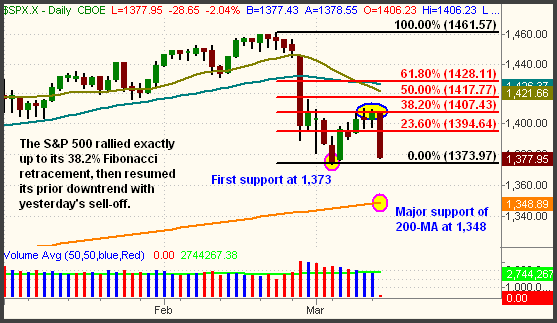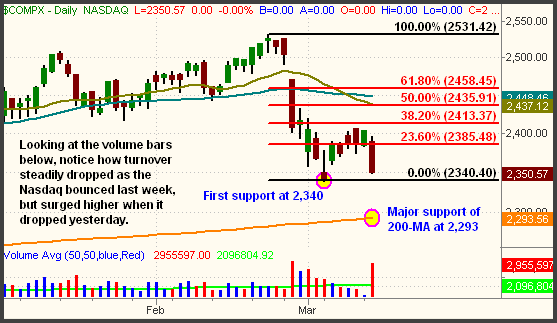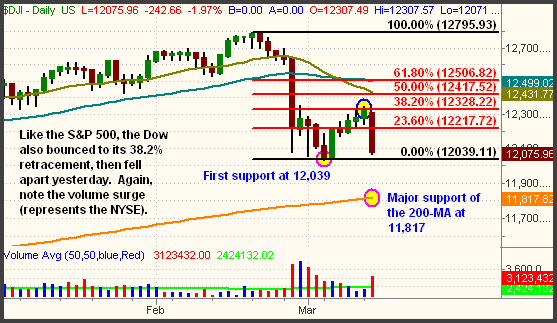|
The Wagner Daily ETF Report for March 14
We didn't know exactly when, but odds were good that it would happen soon. A single day of institutional selling wiped out the broad market's five-day uptrend off the March lows. After opening lower, stocks initially attempted to rally on the heels of a strong earnings report from brokerage giant Goldman Sachs, but the valiant recovery effort failed. By mid-day, each of the major indices had reversed to new intraday lows, triggering a rush of downside momentum. The S&P 500, Dow Jones Industrial Average, and S&P Midcap 400 indices each fell 2.0%, while the Nasdaq Composite lost 2.2%. The small-cap Russell 2000 plunged 2.5%, causing our long position in the UltraShort Russell 2000 ProShares (TWM) to zoom 5% higher. The drop in the S&P 500 similarly enabled our long position in the UltraShort S&P 500 ProShares (SDS) to gain nearly 4%. Each of the major indices closed at their absolute intraday lows, showing not even a hint of short covering into the close.
Not surprisingly, sharply higher volume matched yesterday's sell-off. Total volume in the NYSE spiked 33% above the previous day's level, while volume in the Nasdaq increased by 36%. Turnover in both exchanges was much higher than it was on any one of the "up" days since the March 5 lows. Yesterday's market action was a clear example of what we have been warning about since the beginning of last week's bounce. When a market that has broken major support eventually attempts to bounce, its "up" days must also coincide with increasing volume in order for the gains to hold. But when the "up" days exhibit successively lighter volume every single day, we cautioned that a single day or two of higher volume selling ("institutional distribution") can erase the entire short-term uptrend. This is what occurred yesterday. Extremely ugly market internals nearly matched the negative breadth of the February 27 plunge. In both exchanges, declining volume annihilated advancing volume by a ratio of approximately 18 to 1! The selling was quite broad-based, as every major industry sector closed in the red.
Now that a resumption of their intermediate-term downtrends appears to be under way, what should we expect from the major market indices in the coming days? To answer that question, we will take an updated look at the support and resistance levels of the S&P, Nasdaq, and Dow. Below is a daily chart of the S&P 500:

First, it is interesting to note that the S&P 500 bounced almost exactly to the 38.2% Fibonacci retracement level before resuming its downtrend yesterday. When the S&P began its recovery attempt on March 6, we mentioned that the index should at least make it to the 23.6%, and possibly the 38.2% Fibonacci retracement level, before moving lower. As you can see above, the 38.2% retracement marked the high of the bounce (circled in blue). This alone tells us that the market is in a strong downtrend because weaker trends (both up and down) will often retrace to their 50% or 61.8% level before resuming their primary trends. Further, the 20-day moving average (the beige line) has crossed down below the 50-day moving average (the teal line), confirming the new downtrend.
The S&P 500 closed just above its prior low of March 5. Traders will definitely be watching how the market reacts as it approaches this key support level in today's session. One possibility is that the index will dip below the March 5 low of 1,373, run a bunch of sell stops, then attempt to stabilize near that level. If that occurs, expect the original 23.6% retracement at 1,394 to act as the first area of overhead resistance on any subsequent rally attempt. But given that the S&P only retraced a little more than one-third of its recent losses, and did so on very light volume, the index is more likely to make a firm break below the 1,373 low. If it does, the 200-day moving average at 1,348 should become the next major area of price support. A rapid move down to that level would provide an ideal exit point on any short positions that you do not want to hold through the next bounce. Next, let's analyze the Nasdaq Composite:

On a relative basis, the bounce in the Nasdaq was weaker than the S&P. The Nasdaq lacked the momentum to even carry it to the 38.2% Fibonacci retracement level before heading south again. The support and resistance levels are correspondingly the same as the S&P. Since the Nasdaq closed yesterday only 10 points above its March 5 low of 2,340, expect a test and probable probe below that level today. If the index attempts to hold, look for resistance at the 23.6% Fibonacci retracement of 2,385. If not, a rapid move down to the 200-day MA at 2,293 could easily transpire. Finally, here is the Dow Jones Industrials:

Like the S&P 500, the Dow also touched resistance of its 38.2% Fibonacci retracement before resuming the downtrend. Support of the March 5 low is at 12,039, only 37 points below yesterday's closing price. Resistance of the 23.6% retracement remains at 12,214, while pivotal support of the 200-day MA is at 11,817.
Personally, I think the market still feels quite heavy and could easily collapse below its March lows. HOWEVER, don't forget that the stock market doesn't care, nor has it ever cared, what I, or any other trader, thinks it will do. In other words, remember to trade what you see, not what you think! Continue trading on the short side, following the current trend, until the market gives us a reason not to. If you're not comfortable with short selling, we suggest you wait patiently on the sidelines, preserving capital, locked and loaded with cash reserves.
Deron Wagner is the Founder and Head Trader of both Morpheus Capital LP, a U.S. hedge fund, and Morpheus Trading Group, a trader education firm launched in 2001 that provides daily technical analysis of the leading ETFs and stocks. For a free trial to the full version of The Wagner Daily or to learn about Wagner's other services, visit MorpheusTrading.com or send an e-mail to deron@morpheustrading.com.
|